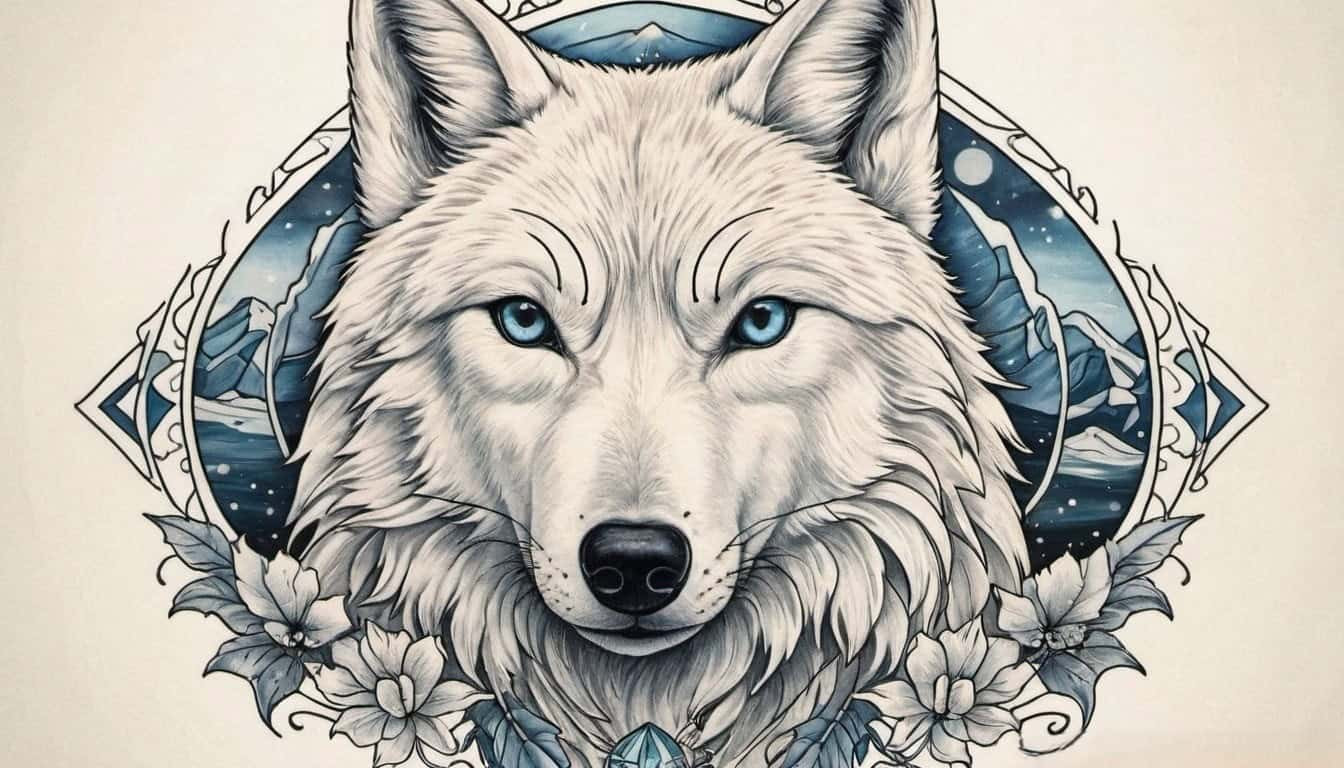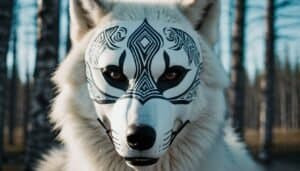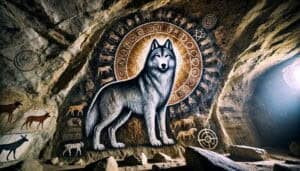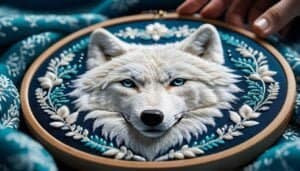Introduction
Arctic wolves hold a significant place in the tattooing traditions of Arctic communities
This article explores the deep-rooted historical significance and cultural beliefs associated with Arctic wolves, reflected in various tattoo designs and styles. We will delve into the common motifs and symbolism, examining how these traditions have evolved and are preserved today
Additionally, we will look at the techniques and rituals involved in creating these intricate tattoos, shedding light on their spiritual and cultural importance
Historical Significance of Arctic Wolves in Tattooing
Arctic wolves have played a crucial role in the cultural and spiritual lives of indigenous Arctic communities for centuries. These majestic creatures are often featured in traditional tattooing practices, symbolizing various aspects of life, survival, and spirituality
Understanding the historical significance of Arctic wolves in Arctic tattooing involves exploring early tattooing practices, the symbolic importance of the wolves, and the cultural narratives and myths that have shaped these traditions
Early Arctic Tattooing Practices
Tattooing has been a significant cultural practice among Arctic communities, dating back thousands of years. Arctic tattoos often served as markers of identity, social status, and rites of passage
In these early practices, tattoos were not merely decorative but held deep meanings tied to the wearer’s life experiences, achievements, and connections to the natural world. Arctic wolves, as prominent inhabitants of the Arctic landscape, naturally became part of these symbolic representations
Tattooing techniques varied among different Arctic cultures, but traditional methods often involved the use of sharpened bones or needles made from animal bones, along with natural dyes derived from soot or plant materials
These tools and materials were carefully prepared and used in ritualistic settings, emphasizing the spiritual significance of the tattoos. The process was often painful, adding to the symbolic weight of the tattoos as marks of endurance and resilience
Symbolic Importance of Arctic Wolves
Arctic wolves are revered in many Arctic cultures for their strength, resilience, and survival skills in the harsh Arctic environment
They are seen as symbols of endurance, loyalty, and protection. In traditional Arctic tattooing, Arctic wolves often represent these qualities, serving as powerful symbols for the individuals who bear their images
For instance, Arctic wolves are often associated with the concept of the guardian spirit, believed to protect individuals from harm and guide them through life’s challenges. Tattoos featuring Arctic wolves might be placed in prominent locations on the body, such as the chest, back, or arms, to invoke these protective qualities
The imagery of the Arctic wolf can also be linked to hunting prowess and survival skills, reflecting the critical role these animals play in the daily lives and sustenance of Arctic communities
Cultural Narratives and Myths
The cultural narratives and myths surrounding Arctic wolves are rich and varied, with each community holding unique stories that underscore the wolves’ significance
These myths often portray Arctic wolves as wise and noble creatures, capable of extraordinary feats and possessing deep spiritual wisdom. In some stories, Arctic wolves are considered ancestors or totem animals, linking individuals to their heritage and the natural world
One common narrative involves the Arctic wolf as a guide or companion to humans, helping them navigate the treacherous Arctic landscape and teaching them essential survival skills. Tattoos depicting these stories serve as reminders of these lessons and the close relationship between humans and wolves in Arctic mythology
In Inuit culture, for example, the Arctic wolf is often featured in legends that highlight its role as a protector and guide. These stories are passed down through generations, preserving the cultural heritage and ensuring that the significance of the Arctic wolf remains alive in contemporary tattooing practices
The integration of these narratives into tattoo designs helps maintain a connection to ancestral traditions and the natural world, reinforcing the cultural identity of the wearer
Cultural Beliefs and Symbolism
Cultural beliefs and symbolism play a significant role in how Arctic wolves are featured in traditional Arctic tattooing
These tattoos are not merely aesthetic choices but carry deep spiritual and cultural meanings. By understanding the beliefs and symbolism associated with Arctic wolves, we can gain insight into their importance in the tattooing traditions of Arctic communities
Arctic Wolves in Indigenous Beliefs
Arctic wolves hold a special place in the belief systems of various indigenous Arctic communities. They are often seen as embodying the spirit of the wild and are revered for their strength, intelligence, and survival skills. These attributes make them powerful symbols in the cultural and spiritual landscape of Arctic peoples
In many indigenous beliefs, Arctic wolves are considered spirit animals or totems that offer protection and guidance
They are believed to possess qualities that humans can aspire to, such as endurance, loyalty, and cunning. As a result, tattoos featuring Arctic wolves are often seen as a way to connect with these attributes and draw on the wolf’s spirit for strength and protection
For example, the Inuit people regard the Arctic wolf, or “Amarok,” as a solitary creature of great power and mystery. Tattoos of the Amarok are believed to provide protection against evil spirits and bring good fortune. The symbolism of the Arctic wolf in these tattoos reflects the deep respect and admiration that indigenous peoples have for these animals
Spiritual Significance
The spiritual significance of Arctic wolves in tattooing traditions is profound. Tattoos are seen as a form of communication with the spiritual world, and the imagery of the Arctic wolf is used to invoke spiritual protection, guidance, and strength. These tattoos often have specific meanings and are used in rituals and ceremonies to mark important life events or transitions
In many Arctic cultures, tattoos of Arctic wolves are used as part of initiation rites or coming-of-age ceremonies
These tattoos symbolize the individual’s journey into adulthood and their connection to the spiritual world. The process of receiving a tattoo is often accompanied by rituals and prayers, emphasizing the spiritual dimension of the practice
The placement of Arctic wolf tattoos can also hold spiritual significance. For instance, tattoos on the chest or heart area might symbolize the wearer’s desire for courage and strength, while tattoos on the back could represent protection and support
The spiritual meanings attached to these tattoos are deeply personal and reflect the individual’s relationship with the Arctic wolf and their cultural heritage
Representation in Art and Tattoos
Arctic wolves are a common motif in Arctic art, including tattoos. The representation of these animals in tattoo designs can vary widely, from realistic depictions to abstract and stylized forms. These designs often incorporate other elements of Arctic culture, such as snowflakes, ice, and the northern lights, to create a rich tapestry of symbolism and meaning
Traditional Arctic wolf tattoos might feature intricate patterns and lines that reflect the natural environment and the cultural aesthetics of the community
These designs are often created with great care and attention to detail, reflecting the skill and artistry of the tattooist. The use of natural dyes and traditional tattooing methods further enhances the cultural authenticity of these tattoos
Modern interpretations of Arctic wolf tattoos can blend traditional elements with contemporary styles. For example, some tattoos might use bold lines and geometric patterns to create a striking visual effect, while others might incorporate color and shading to enhance the realism of the wolf’s image. Regardless of the style, the underlying symbolism of the Arctic wolf remains a central element of the design
In contemporary Arctic tattooing, there is a growing emphasis on preserving traditional designs and techniques while also allowing for creative expression and innovation. This balance ensures that the cultural significance of Arctic wolf tattoos is maintained, even as new generations of artists and wearers bring their unique perspectives to the practice
Common Designs and Styles
The designs and styles of Arctic wolf tattoos vary greatly, reflecting both traditional elements and modern interpretations. These tattoos are rich in symbolism and carry deep cultural meanings, often specific to the community and the individual
This section explores traditional Arctic wolf tattoo designs, modern interpretations, and gender-specific designs
Traditional Arctic Wolf Tattoo Designs
Traditional Arctic wolf tattoos are deeply rooted in the cultural heritage of Arctic communities
These designs often incorporate intricate patterns and symbols that represent the natural environment and the spiritual beliefs of the people. The imagery is typically stylized, with a focus on capturing the essence of the Arctic wolf rather than a realistic depiction
Common traditional designs include:
Abstract Patterns: Many traditional tattoos use abstract patterns and geometric shapes to represent the Arctic wolf. These patterns can include lines, dots, and other shapes that create a stylized image of the wolf
Cultural Symbols: Elements such as snowflakes, ice, and the northern lights are often included in the designs, reflecting the natural world and the cultural context in which these tattoos are created
Spiritual Elements: Designs might also incorporate symbols related to spiritual beliefs, such as representations of guardian spirits or totem animals
These traditional tattoos are often created using ancient techniques, such as hand-poking or skin stitching, which involve using sharp bones or needles and natural dyes. The process is usually accompanied by rituals and prayers, emphasizing the spiritual significance of the tattoos
Modern Interpretations
Modern interpretations of Arctic wolf tattoos blend traditional elements with contemporary tattooing styles. These designs often feature a mix of realism and abstraction, creating unique and visually striking tattoos that still honor their cultural roots
Popular modern styles include:
Realistic Portraits: Some modern tattoos aim for a highly realistic depiction of the Arctic wolf, using shading and color to create a lifelike image. These tattoos often highlight the wolf’s natural beauty and majesty
Geometric and Abstract Styles: Contemporary artists might use bold lines, geometric shapes, and abstract patterns to create a modern take on the traditional designs. This style can emphasize the wolf’s strength and resilience in a new and innovative way
Mixed Media: Combining different styles and techniques, such as blending realism with abstract elements or incorporating watercolor effects, allows for a personalized and creative expression of the Arctic wolf
These modern designs are often created using advanced tattooing equipment and techniques, allowing for greater precision and detail. Despite the contemporary approach, the tattoos retain their deep cultural and spiritual meanings, connecting the wearer to their heritage
Gender-Specific Designs
In many Arctic cultures, tattoo designs can be gender-specific, reflecting different roles, responsibilities, and spiritual beliefs. This distinction is also evident in Arctic wolf tattoos, where the designs might vary based on the gender of the wearer:
Women’s Designs: Women’s tattoos often include delicate and intricate patterns that symbolize fertility, protection, and connection to the earth. Arctic wolf tattoos for women might feature smaller, more detailed designs placed on areas like the hands, wrists, or face
Men’s Designs: Men’s tattoos tend to be larger and bolder, symbolizing strength, bravery, and hunting prowess. Arctic wolf tattoos for men might be placed on the chest, back, or arms, emphasizing the wearer’s connection to the wolf’s powerful attributes
Unisex Designs: Some designs are unisex, suitable for anyone regardless of gender. These tattoos focus on the universal qualities of the Arctic wolf, such as resilience, loyalty, and spiritual protection
The choice of design and placement is deeply personal and often influenced by the individual’s experiences, beliefs, and cultural background. These gender-specific designs help maintain cultural traditions while allowing for personal expression
Techniques and Rituals in Arctic Tattooing
The techniques and rituals involved in Arctic tattooing are as significant as the designs themselves. These practices have been passed down through generations, preserving the cultural heritage and spiritual meanings of the tattoos
This section explores traditional tattooing methods, the tools and materials used, and the rituals and ceremonies associated with Arctic tattooing
Traditional Tattooing Methods
Traditional Arctic tattooing methods are deeply rooted in the cultural practices of Arctic communities. These methods often involve hand-poking or skin stitching, techniques that have been used for thousands of years:
Hand-Poking: This method involves using a sharp implement, often made from animal bones or needles, to manually insert ink into the skin. The artist carefully pokes the skin to create the desired design, a process that requires precision and skill. Hand-poking is known for its distinct look, with lines that are often more organic and less uniform than those made with modern machines
Skin Stitching: Skin stitching is another traditional method, where a needle and thread coated with ink are used to stitch the design into the skin. This technique can create intricate patterns and is often used for detailed designs. The process can be more painful and time-consuming but results in a unique texture and appearance
Tapping: Some Arctic cultures also use a method called tapping, where the artist taps a sharp tool into the skin with a rhythmic motion to apply the ink. This method is similar to hand-poking but can cover larger areas more quickly
These traditional methods are not only artistic practices but also hold spiritual significance. The act of tattooing is often seen as a rite of passage, with the pain and endurance involved symbolizing the wearer’s strength and resilience
Tools and Materials Used
The tools and materials used in traditional Arctic tattooing are often sourced from the natural environment and prepared with great care and respect:
Needles and Implements: Traditional tools are commonly made from animal bones, such as those from seals or caribou, which are sharpened to a fine point. Metal needles, if available, might also be used. These tools are meticulously crafted to ensure precision and safety
Ink and Dyes: The ink used in traditional tattoos is usually derived from natural sources. Soot from burned animal fat or plant materials is a common ingredient, mixed with seal oil or other natural oils to create a dark, durable ink. These natural inks are believed to hold spiritual properties, connecting the wearer to the earth and the animals
Preparation and Sterilization: Traditional practices often include methods for cleaning and sterilizing tools, such as using fire or boiling water. The preparation of the ink and tools is accompanied by rituals and prayers, emphasizing the sacred nature of the tattooing process
Rituals and Ceremonies
Rituals and ceremonies are integral to the Arctic tattooing tradition, imbuing the tattoos with deep spiritual and cultural significance:
Preparation Rituals: Before the tattooing begins, there are often rituals to prepare both the artist and the wearer. These might include prayers, offerings, and purification ceremonies to ensure a safe and successful tattooing process
Tattooing Ceremony: The act of tattooing is usually conducted in a ceremonial setting, with the presence of family members and community elders. The ceremony might include singing, chanting, and storytelling, creating a supportive and sacred environment
Post-Tattoo Rituals: After the tattoo is completed, there are often rituals to aid in healing and to honor the new tattoo. These might include applying medicinal herbs, performing dances, or holding feasts to celebrate the wearer’s new mark and the meanings it holds
These rituals and ceremonies help to maintain the cultural integrity of the tattooing practice, reinforcing the spiritual connections and communal bonds that the tattoos represent
Conclusion
Arctic wolves play a vital role in the tattooing traditions of Arctic communities, embodying rich cultural, spiritual, and historical significance
From the early practices that utilized natural materials and traditional techniques to the intricate designs that carry deep symbolic meanings, Arctic wolf tattoos are a testament to the enduring legacy of Arctic heritage
The exploration of Arctic wolves in tattooing reveals their symbolic importance, reflecting qualities such as strength, resilience, and protection. These tattoos serve as powerful connections to the spiritual beliefs and cultural narratives that have been passed down through generations. As we have seen, traditional methods like hand-poking and skin stitching are preserved through contemporary practices, ensuring the survival of these ancient techniques
Efforts to document and preserve these traditions are crucial for maintaining their cultural integrity. Community-led initiatives and cultural heritage projects play a significant role in safeguarding these practices, while educational efforts help to pass on knowledge to younger generations
Additionally, the influence of modern tattooing trends has led to a dynamic fusion of styles, allowing for innovation while respecting traditional values
As Arctic tattooing continues to evolve, it remains a vibrant expression of cultural identity and a profound link to the past. The preservation and adaptation of these traditions ensure that the spiritual and cultural significance of Arctic wolves in tattooing will endure for future generations











